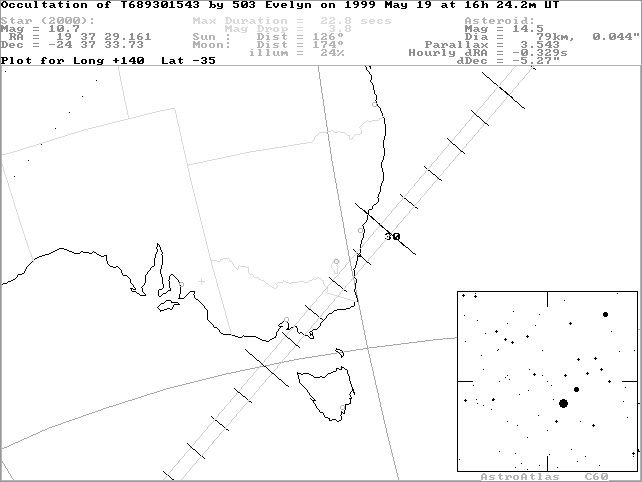ASTROMETRIC UPDATE:
OCCULTATION BY (503) EVELYN - 1999 MAY 19
CHECK THIS PAGE REGULARLY FOR FURTHER UPDATES AND CHANGES TO THE TRACK.
YOU MUST RELOAD THIS PAGE USING YOUR BROWSER'S
RELOAD/REFRESH BUTTON TO OBTAIN UPDATES!
[Prediction by Edwin Goffin]
[Prediction using OCCULT software]
This event appears very favourably placed for southeastern Australia.
Goffin's prediction places the path a little south of Brisbane and Adelaide. The OCCULT prediction lies marginally south of Sydney, Canberra and Melbourne
UPDATE 2: 18 May 1999
Further to Update 1 below, Ron Stone at USNO Flagstaff has, at the request of Jan Manek, supplied an additional position of Evelyn obtained on May 14. Manek has calculated a new update based on the (now) two 1999 positions, plus 25 1998 positions.
Manek's comments and full event summary:
The calculation gives a significant SE path shift and time ~3 minutes later compared to Goffin's nominal path. This shift puts the path over the very southeastern part of Australia (eastern Victoria and SE of New South Wales). Current uncertainities give chances also to Melbourne, Canberra and Sydney, and also to the northwestern part of Tasmania.
The uncertainity seems to be large but it is because the asteroid is moving very slowly - only 7"/hour - so even a small error in the star/asteroid position translates into a large path shift/time correction. On the other hand the slow motion gives also a full 23 second occultation for this only 80km asteroid. Although the star is faint, the event takes place near the zenith and the target star should be easy to locate.
The event at one glimpse:
- Date and approx. UT time of event: May, 19, 1999 @ 16:34 UT
- Magnitude of target star: 10.6
- Magnitude drop [mag]: 3.9
- Estimated maximum duration [s]: 23.1
- Path description: Path now crosses SE part of Australia (eastern Victoria and SE of New South Wales). Current uncertainities give chances also to Melbourne, Canberra and Sydney to name the larger cities and also to NW part of Tasmania.
The Occultation Path:
- Approximate width [km]: 80
- Uncertainty [path widths]: 4
- Uncertainty in time [s]: 85 (or ~1.4 minutes !)
- Map: See below
- Remarks: Uncertainities are given on the basis of the nominal errors of the observations.
NOTE:
Circles along the path are OCCULT calculated exact centerline points.
This is important for this event as Evelyn has very slow motion.
Data for the target star:
- Name: TYC 6893 01543 1
- Constellation: Sagittarius
- J2000 position [h,m,s; o,',"]: 19h 37m 29.161s; -24o 37' 33.73"
- Position source: ACT
- Estimated accuracy ["]: 0.075" (0.06", 0.04")
- V mag [mag]: 10.60
- B-V [mag]: +0.55
- Remarks: Target star is about 20' NW of a pair of stars 52 Sgr (4.6 mag) and 51 Sgr (5.7 mag). These are in the NW part of Sagittarius. TYCHO gives quality parameter 5 (medium) with Z flag (no investigation for duplicity).
Data for the minor planet:
- Number, name: (503) Evelyn
- Approx. diameter [km]: 80
- Orbit source: calculation Manek
- Source of used astrometry: USNO/Flagstaff (Ron Stone)
- Number of used observations: 27 USNO
- Number of rejected observations: 0
- Time covered by the observations: 1998 02 12 - 1999 5 14
- Rms residuals ["] (RA,DE): 0.10", 0.08"
- Estimated positional accuracy at epoch of event ["]: 0.10"
- Remarks: There are only two positions from this year with O-C in both coordinates ~0.12", about the same as the whole orbit solution.
Data for the event:
- UT date and time of least geocentric approach: 16:23:00 UT
- Approx. V mag of minor planet at event [mag]: 14.5
- Geocentric parallax of minor planet ["]: 3.543
- Magnitude drop [mag]: 3.9
- Estimated maximum duration [s]: 23.1
- Apparent motion of minor planet ["/h]: 6.92
- Angular distance to moon, phase of moon [deg,%]: 174, 24%

UPDATE 1: 17 May 1999
This update has been calculated by Graham Blow using OCCULT software and is based on 1 astrometric position of the asteroid obtained at the U.S. Naval Observatory Flagstaff Station on May 13. (Additional astrometry back as far as February 1998 is also available, but OCCULT cannot use these data). The ACT position of the star has been used for the prediction.
Event Summary:
- Target star : TYC 6893 01543
- Star Magnitude : 10.66
- J2000 position : 19h 37m 29.161s; -24o 37' 33.73"
- Magnitude drop at occultation : 3.8
- Estimated maximum duration : 23.0 secs
Path Update:
- The updated path is essentially coincident with the OCCULT prediction. Sydney, Canberra and Melbourne all lie less than one half of a path width north of the track.
- There is a time shift of approximately -2 minutes compared to the original OCCULT prediction. The time for Sydney is ~16:30 UT, and for Melbourne ~16:34 UT

IMPORTANT NOTE!
Astrometric updates such as these should not be taken as definitive, but rather only as an indication of where the true track may lie relative to the original predicted track. Observers must bear in mind that later astrometry, in which the target star is measured in the same field as the asteroid, may still reveal substantial changes to the predicted track and time of the event. For this reason it is most important that observers far from the predicted track still monitor the event.
Use these links for further information:
[Planetary Occultations]
[Using the Predictions]
[Observing Details]
[Timing Details]
[Reporting Details]
[Report Form]
[Asteroid Occultation Results]
This page may have been updated since 17 May 1999.
Hit your browser's RELOAD button to get the latest version.
[Site Map]
[What's an Occultation?]
[Total Occultations]
[Grazing Occultations]
[Planetary Occultations]
[Jovian Satellite Eclipses]
[Timing Occultations]
[Reporting Observations]
[Coming Events]
[About Us]
[Publications]
[Membership]
[Links]
[Top of Page][Return to Home Page]

